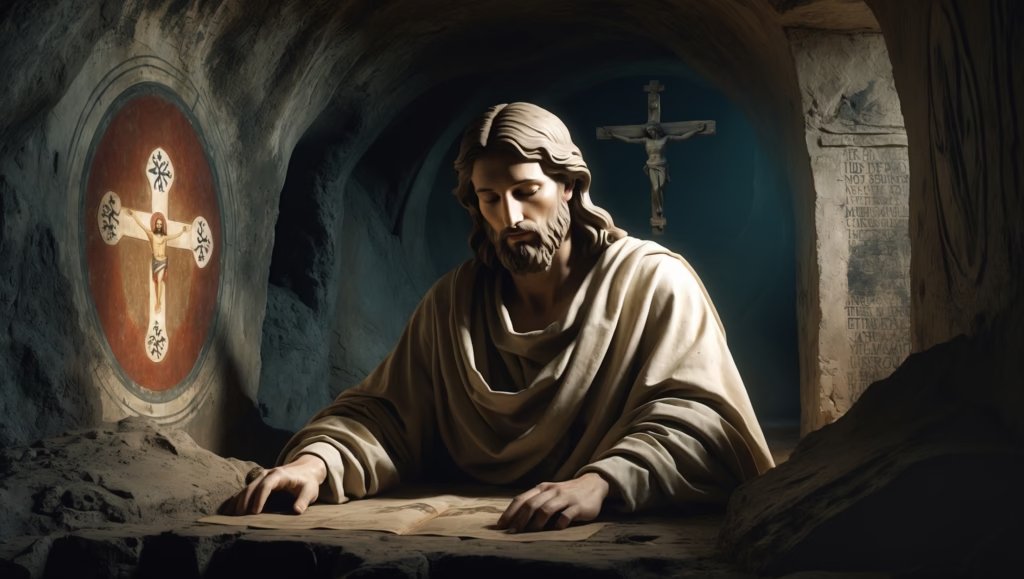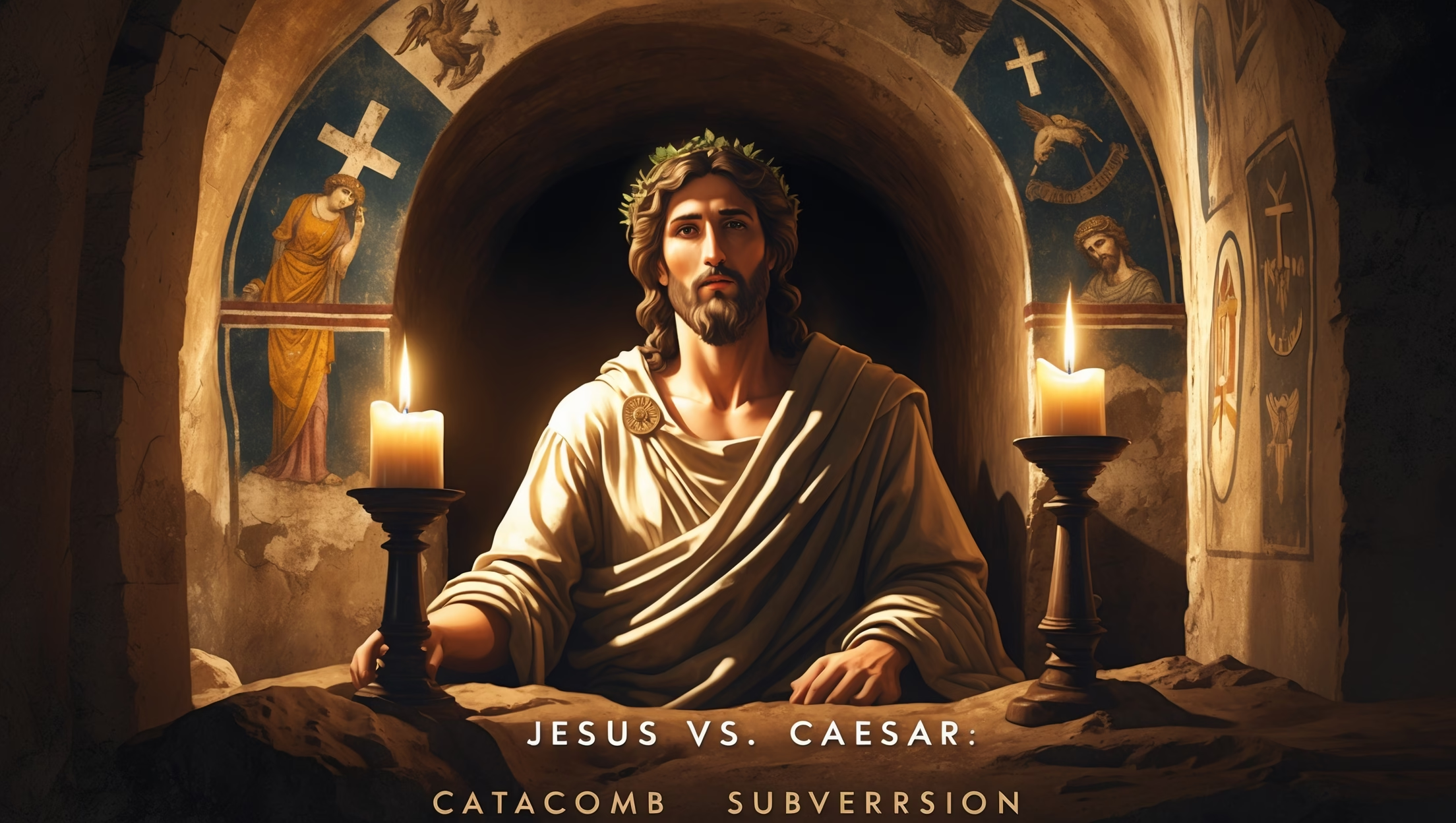Early Christian Resistance Through Art and Symbolism
In the Roman Empire, Christians were a minority navigating a complex landscape of religious authority, imperial propaganda, and occasional persecution. Amid these pressures, early believers found creative ways to assert their faith, critique the state, and maintain community cohesion. One of the most fascinating manifestations of this resilience was artistic subversion within catacombs, house churches, and hidden worship spaces. By embedding Christological symbols alongside everyday imagery, early Christians subtly resisted Roman authority and communicated their beliefs in ways intelligible only to the initiated.

1. The Political Landscape: Jesus vs. Caesar
The title of “Caesar” implied divine authority. Roman emperors were worshiped as gods or semi-divine figures, with imperial propaganda portraying them as “shepherds of peoples” or the guarantors of Pax Romana. For Christians, however, Jesus was the true Lord (Kyrios), a claim that subverted the religious legitimacy of the emperor.
- Imperial Cult: Temples, coins, and public ceremonies reinforced Caesar’s godhood.
- Christian Counter-Claim: Baptismal formulas and house church liturgies declared “Jesus is Lord,” reframing divine allegiance as an ethical and theological protest.
- Risk: Open defiance could result in fines, imprisonment, or execution. Hence, early Christians turned to coded symbolism for both worship and resistance.
2. Hidden Symbolism in Catacombs
Catacombs—subterranean burial sites outside Rome—served as clandestine worship spaces. Archaeologists have uncovered a variety of Christological symbols with layered meanings:
Ichthys (Fish)
- Acronym: In Greek, ΙΧΘΥΣ = Iēsous Christos, Theou Yios, Sōtēr (“Jesus Christ, God’s Son, Savior”).
- Political Subtext: Mocked the Roman fish-god Dagon while signaling communal faith.
- Practical Function: Identified meeting spots and burial markers for Christians while remaining opaque to outsiders.
Good Shepherd Motif
- Visual Description: Jesus depicted carrying a lamb, surrounded by sheep.
- Subversive Meaning: Contrasted with imperial imagery of Caesar as “shepherd of peoples.”
- Theological Layer: Communicated care, protection, and moral authority independent of state power.
Orans Figures
- Posture: Prayer with outstretched arms.
- Function: Represented communal and individual prayer while subtly defying emperor worship.
- Hidden Messaging: Served as a visual “prayer of resistance,” asserting spiritual autonomy under political duress.
3. Archaeological Evidence
Recent discoveries continue to illuminate how early Christians employed subtle subversion in their art:
- 2023 Roman House Church: Excavation beneath a villa revealed a 3rd-century worship space with mosaics incorporating crosses disguised as geometric patterns.
- Painted Walls: Scenes of biblical miracles and shepherds were intermixed with everyday Roman motifs, masking religious content from authorities.
- Graffiti and Inscriptions: Ichthys symbols and abbreviated prayers provided guidance for worship while maintaining secrecy.
These artifacts reveal that early Christian creativity was both devotional and political, allowing believers to maintain identity under surveillance.
4. Theological Significance
Catacomb art was more than subversive—it expressed core theological convictions:
- Christ as True Lord: Visual codes reinforced Jesus’ divine authority over earthly rulers.
- Ethical Witness: Symbols highlighted moral responsibility, care for community, and opposition to tyranny.
- Hope Beyond Death: Burial iconography intertwined Christ’s resurrection with visions of justice and divine vindication, providing comfort under persecution.
Through these images, early Christians communicated both faith and critique, asserting a divine alternative to imperial power.
5. Modern Parallels
The strategies of early Christians resonate with contemporary faith communities navigating authoritarian or restrictive environments:
- Chinese Underground Churches: Use emojis, coded language, and digital platforms to share Scripture while avoiding government censorship.
- Middle Eastern Christian Art: Public murals employ subtle symbols to assert faith amidst political instability.
- Digital Subversion: Social media graphics, memes, and virtual worship spaces echo the hidden-but-visible strategy of the catacombs.
In each case, faith communities adapt visual, textual, and digital symbols to maintain religious identity while negotiating power structures.
6. Lessons from Catacomb Subversion
The early Christian use of hidden symbolism offers several enduring insights:
- Creativity as Resistance: Faithful expression often flourishes under constraints, producing enduring cultural and spiritual artifacts.
- Subtlety and Clarity: Symbols must be intelligible to insiders while opaque to outsiders—a balance between community cohesion and safety.
- Endurance of Message: Like catacomb art, modern religious symbolism can persist and influence subsequent generations, even under persecution.
- Ethical Engagement: The imagery promoted moral critique alongside spiritual devotion, demonstrating that religious practice can serve both devotional and civic functions.
7. Conclusion
The story of Jesus vs. Caesar is not only theological but also cultural, artistic, and political. Early Christians transformed humble catacombs and domestic spaces into arenas of spiritual resistance, employing symbols like the Ichthys, Good Shepherd, and Orans figures to assert Christ’s lordship against imperial authority. These subversive acts were both protective and prophetic, preserving community identity while critiquing oppressive power.
Modern faith communities continue this legacy, using digital media, public murals, and coded communication to assert beliefs in hostile contexts. The catacomb strategy reminds us that art, faith, and resistance are deeply intertwined, and that sacred imagery can serve as both devotional inspiration and a tool for ethical witness.
In a world where political, social, and religious pressures remain, the lessons of catacomb subversion are timeless: creativity, courage, and conviction can carry profound messages across generations, proving that even in hiding, faith can flourish.








